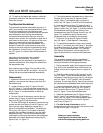
655 and 655R Actuators
Instruction Manual
Form 1292
July 2007
9
diaphragm casing (key 5). Some Type 655R
actuators will have travel stops (key 13, not shown)
in place of three of these six cap screws.
9. If a top-mounted handwheel assembly is used,
refer to steps 4 through 8 of the Disassembly portion
of the Top-Mounted Handwheel section.
Assembly
This procedure assumes that the actuator is
completely disassembled. If it is not, start the
instructions at the appropriate step.
1. Before starting assembly, apply moly-grease
lubricant to the threads and the bearing end of the
adjusting screw (key 10) as indicated in figure 4 by
the letter A.
2. For size 3A and 4A actuators, set the lower
diaphragm casing (key 5) onto the yoke (key 7).
3. For size 3B through 46 actuators, install the lower
diaphragm casing (key 5), and secure it with the cap
screws (key 21). Some Type 655R actuators will
have travel stops (key 13, not shown) in place of
three of these six cap screws.
4. Install the lower spring seat (key 9) and the
actuator spring (key 6).
Note
To take some of the slack out of the
diaphragm (key 2) at the bolt circle, turn
the adjusting screw into the yoke
(key 7) to raise the diaphragm plate
(key 4). This will also ensure that the
diaphragm will have enough slack
inside the casings for efficient travel.
5. Secure the diaphragm plate (key 4) to the
actuator stem (key 8) with the cap screw (key 3),
and install this assembly into the actuator. Install the
diaphragm, making sure that the patterned side of
the diaphragm is next to the diaphragm plate.
Note
When replacing the upper diaphragm
casing (key 1), be sure there are no
wrinkles in the diaphragm that might
cause the diaphragm to tear or allow
leakage.
6. Place the upper diaphragm casing onto the lower
diaphragm casing. For size 3A and 4A actuators,
secure the casings with the cap screws (key 19). For
all other actuator sizes, secure the casing with the
cap screws and hex nuts (keys 19 and 20).
Note
When you replace actuator
diaphragms in the field, take care to
ensure the diaphragm casing bolts are
tightened to the proper load to prevent
leakage, but not crush the material.
Perform the following tightening
sequence with a manual torque
wrench.
CAUTION
Over-tightening the diaphragm cap
screws (key 19) or cap screws and
nuts (keys 19 and 20) can damage the
diaphragm. Do not exceed 27 NSm (20
lbfSft) torque.
Note
Do not use lubricant on these bolts
and nuts. Fasteners must be clean and
dry.
7. Install the upper diaphragm casing (key 1), and
install the cap screws (key 19) or cap screws and
nuts (keys 19 and 20). Tighten in the following
manner.
8. The first four bolts tightened should be
diametrically opposed and 90 degrees apart. Tighten
these four bolts to 13 NSm (10 lbfSft).
9. Tighten the remaining bolts in a clockwise,
criss-cross pattern to 13 NSm (10 lbfSft).
10. Repeat this procedure by tightening four bolts,
diametrically opposed and 90 degrees apart, to a
torque of 27 NSm (20 lbfSft).
11. Tighten the remaining bolts in a clockwise,
criss-cross pattern to 27 NSm (20 lbfSft).
12. After the last bolt is tightened to 27 NSm
(20 lbfSft), all of the bolts should be tightened again
to 27 NSm (20 lbfSft) in a circular pattern around the
bolt circle.
13. Once completed, no more tightening is
recommended.
14. Mount the actuator onto the valve by following
the procedures outlined in the Actuator Mounting
portion of the installation section.
15. Connect the pressure control line by following
the procedures outlined in the Loading Connections
portion of the Installation section.


















